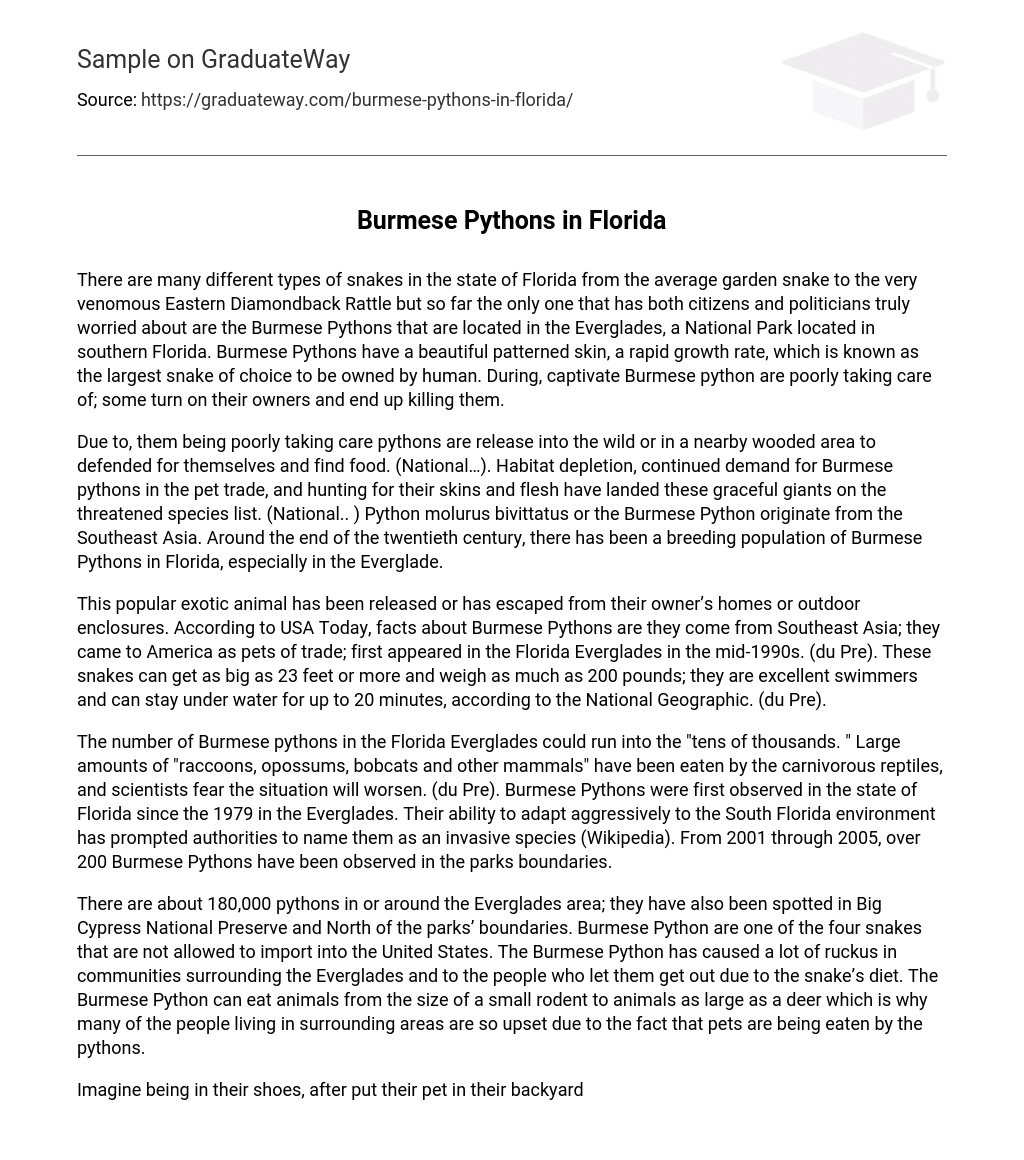Florida has a diverse range of snakes, from harmless garden snakes to the dangerous Eastern Diamondback Rattlesnakes. However, the focus for citizens and politicians is on the presence of Burmese Pythons in the Everglades, a National Park in southern Florida. These pythons have striking patterned skin and grow rapidly, making them popular as pets. Sadly, if not cared for properly, these pythons can attack their owners and even result in fatalities.
Due to negligence in caring for them, pythons are being released into the wild or nearby wooded areas. This has resulted in habitat depletion and a higher demand for Burmese pythons in the pet trade and hunting for their skins and flesh. As a result, these magnificent creatures have been added to the threatened species list. The Burmese Python, scientifically known as Python molurus bivittatus, is native to Southeast Asia. In Florida’s Everglades region, there has been an increasing population of Burmese Pythons.
According to USA Today, the Burmese Python, a popular exotic animal, has either been released or escaped from their owner’s homes or outdoor enclosures. These pythons originate from Southeast Asia and were brought to America as pets for trade. According to du Pre’s report in the mid-1990s, they first appeared in the Florida Everglades. National Geographic states that these snakes can grow up to 23 feet or longer and weigh up to 200 pounds. Furthermore, they possess exceptional swimming abilities and are capable of submerging themselves for up to 20 minutes.
According to du Pre, Florida’s Everglades may be home to “tens of thousands” of Burmese pythons. These carnivorous reptiles have been hunting various mammals such as raccoons, opossums, and bobcats. Scientists are worried about the situation getting worse. The presence of Burmese pythons in the Everglades was first reported in 1979 and they are considered invasive species because they have aggressively adapted to South Florida’s environment, as stated on Wikipedia. Between 2001 and 2005, over 200 Burmese pythons were seen within park boundaries.
There are around 180,000 pythons living in or near the Everglades area. They have also been seen in Big Cypress National Preserve and other areas. Burmese Pythons, which are one of four snake species not allowed to be imported into the United States, have caused significant problems for local communities because of what they eat. They can eat small rodents and even large animals like deer. Because of this, people who live nearby are very concerned about their pets becoming targets for these pythons.
Imagine being in their shoes, where their poor little pet is slowly squeezed to death and eaten by a five-foot snake after being put in their backyard. This is why they turn to their congressman, requesting the removal of these snakes to safeguard their animals. Burmese Pythons, available for as little as twenty dollars in pet shops, have become a lucrative business in the United States. Since 1990, the number of captive-bred snakes has exceeded 112,000. In 2007, nearly 250 snakes were removed from a National Park (Natural Resources…). Burmese Pythons can live for fifteen to twenty-five years, and female pythons can lay a hundred eggs. These hatchlings are larger than native snake hatchlings and grow rapidly with sufficient food. Despite being fierce predators, the Everglades’ pythons face threats from alligators, American crocodiles, black bears, and cougars as their most likely predators (Wikipedia). Considering the numerous factors that can cause harm to Burmese Pythons, stronger legislation should be enacted to protect them from being killed due to their size or because they prey on people’s pets.
The “2013 Python Challenge” took place from late January to February 18th, aiming to capture loose pythons outside of the National Park. The primary focus was on hunting Burmese pythons in the Everglades. A total of 1,600 participants from 38 states, Washington D.C., and Canada joined this competition for a chance to win cash prizes (Tuffley). Throughout the month-long Challenge, 68 pythons were successfully captured. The participant who caught the most pythons received a reward worth $1500, while $1000 was given to the hunter who caught the longest python.
At present, the University of Florida is housing 11 pythons that have been captured in the Everglades. These pythons are being kept there until the contest concludes. The main objective of this contest is to increase awareness about Burmese pythons and their negative effects on the Everglades ecosystem and indigenous wildlife. Additionally, it is crucial to recognize the sense of fulfillment individuals experience when they successfully catch and remove such a highly invasive snake.
The Burmese Pythons, originally native to Southern and Southeast Asia, were introduced as exotic pets. These pythons have a lifespan of up to 25 years and can grow to lengths of 25-26 feet, weighing over 200 pounds. While some see them as potential family pets, others view them as a threat to the Everglades environment. Some people who perceive them as pets may not fully comprehend the challenges associated with caring for these pythons. On the other hand, those who consider the pythons pests are often upset because their own pets have been killed or attacked by them. Despite government efforts to capture some of these pythons, there are still thousands remaining in the Everglades.
Work Cited
“Burmese Python”. National Geographic Society. National Geographic. 1996-2013. Web. 10 Feb. 2013
“Burmese Pythons in Florida”. Wikipedia. 13 Jan. 2013. Wikipedia. 06 Mar. 2013
du Pre, Jolie. “Burmese Pythons: 8 Facts about the Exotic Pet That’s Ruining the Florida Everglades”. Yahoo! News. 31 Jan. 2012. Yahoo! Inc. Web. 10 Feb. 2013.
Greenwood, Faine. “Florida Burmese python hunt begins with 11 catches in the Everglades”. GlobalPost. 15 Jan.2013. GlobalPost International News. Web. 10 Feb. 2013
“Natural Resources Management Burmese Pythons”. South Florida Natural Resources Center. Apr. 2008. 1-2. PDF file. 10 Feb. 2013
Tuffley, Christopher. “68 Pythons down, many still to go.” Print. News Sun,19 Feb. 2013. News Sun. 28 Feb. 2013.





